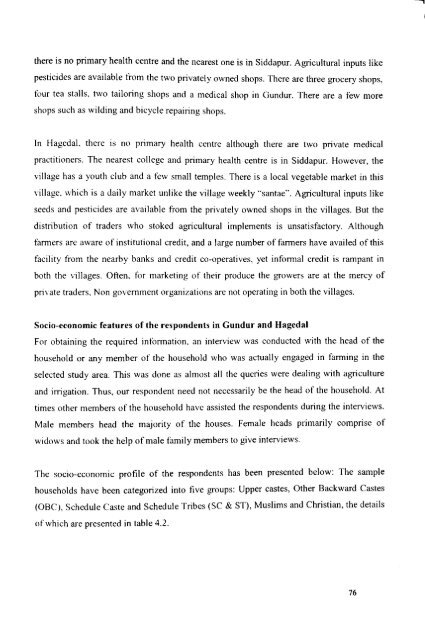Water Users Association and Irrigation Management - Institute for ...
Water Users Association and Irrigation Management - Institute for ...
Water Users Association and Irrigation Management - Institute for ...
You also want an ePaper? Increase the reach of your titles
YUMPU automatically turns print PDFs into web optimized ePapers that Google loves.
there is no primary health centre <strong>and</strong> the nearest one is in Siddapur. Agricultural inputs like<br />
pesticides are available from the two privately owned shops. There are three grocery shops,<br />
four tea stalls, two tailoring shops <strong>and</strong> a medical shop in Gundur. There are a few more<br />
shops such as wilding <strong>and</strong> bicycle repairing shops.<br />
In HagedaJ. there is no pnmary health centre although there are two private medical<br />
practitioners. The nearest college <strong>and</strong> primary health centre is in Siddapur. However, the<br />
village has a youth club <strong>and</strong> a few small temples. There is a local vegetable market in this<br />
village. which is a daily market unlike the village weekly '·santae oo • Agricultural inputs like<br />
seeds <strong>and</strong> pesticides are available from the privately owned shops in the villages. But the<br />
distribution of traders who stoked agricultural implements is unsatisfactory. Although<br />
farmers arc aware of institutional credit, <strong>and</strong> a large number of farmers have availed of this<br />
facility from the nearby banks <strong>and</strong> credit co-operatives, yet in<strong>for</strong>mal credit is rampant in<br />
both the villages. Often, <strong>for</strong> marketing of their produce the growers are at the mercy of<br />
private traders, Non government organizations are not operating in both the villages.<br />
Socio-economic features of the respondents in Gundur <strong>and</strong> HagedaJ<br />
For obtaining the required in<strong>for</strong>mation, an interview was conducted with the head of the<br />
household or any member of the household who was actually engaged in farming in the<br />
selected study area. This was done as almost all the queries were dealing with agriculture<br />
<strong>and</strong> irrigation. Thus, our respondent need not necessarily be the head of the household. At<br />
times other members of the household have assisted the respondents during the interviews.<br />
Male members head the majority of the houses. Female heads primarily comprise of<br />
widows <strong>and</strong> took the help of male family members to give interviews.<br />
The socio-economic profile of the respondents has been presented below: The sample<br />
households have been categorized into five groups: Upper castes, Other Backward Castes<br />
(OBC), Schedule Caste <strong>and</strong> Schedule Tribes (SC & ST), Muslims <strong>and</strong> Christian, the details<br />
of which are presented in table 4.2.<br />
76
















